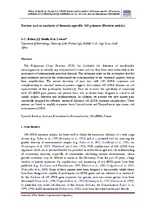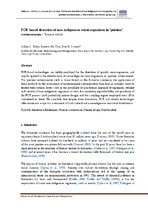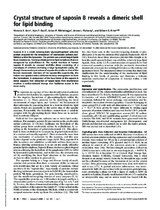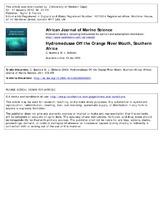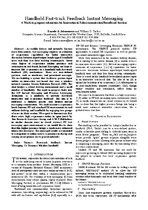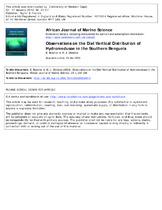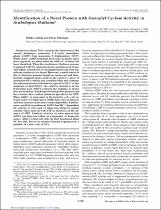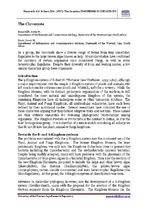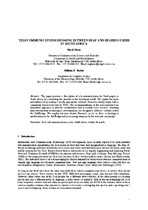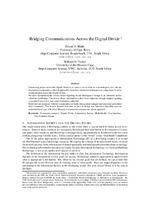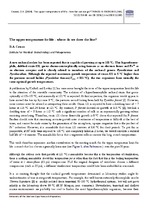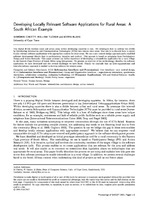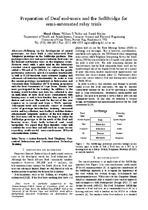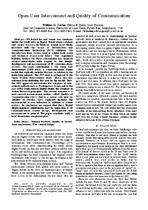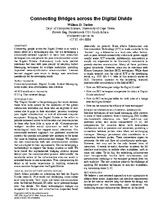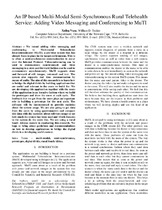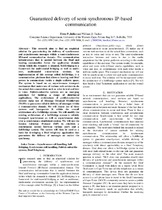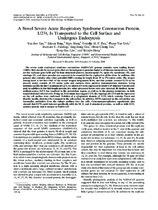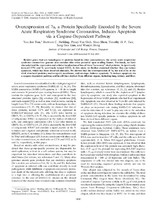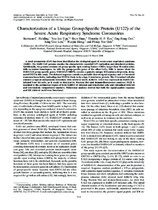Browsing Faculty of Natural Sciences by Issue Date
Now showing items 61-80 of 2571
-
Review and re-analysis of domain-specific 16S primers
(Elsevier, 2003)The Polymerase Chain Reaction (PCR) has facilitated the detection of unculturable microorganisms in virtually any environmental source and has thus been used extensively in the assessment of environmental microbial diversity. ... -
PCR-based detection of non-indigenous microorganisms in ‘pristine’ environments
(Elsevier, 2003)PCR-based technologies are widely employed for the detection of specific microorganisms, and may be applied to the identification of non-indigenous microorganisms in ‘pristine’ environments. For ‘pristine’ environments ... -
Crystal structure of saposin B reveals a dimeric shell for lipid binding
(National Academy of Sciences, 2003)Saposin B is a small, nonenzymatic glycosphingolipid activator protein required for the breakdown of cerebroside sulfates (sulfatides) within the lysosome. The protein can extract target lipids from membranes, forming ... -
Hydromedusae off the Orange River Mouth, Southern Africa
(NISC (Pty) Ltd and Taylor& Francis, 2003)A total of 242 zooplankton samples from the upper 100 m of the water column was collected discontinuously from March 1997 to January 1999 off the Orange River mouth on the west coast of southern Africa. Six species of ... -
Handheld fast-track feedback instant messaging
(Telkom, 2003)As mobile devices and networks become more data-centric, text messaging requires an extension of co-presence capabilities for better interactive discussion between input/output handicapped handheld users and their free ... -
New observations on the diel vertical distribution of Hydromedusae in the southern Benguela ecosystem
(NISC (Pty) Ltd and Taylor& Francis, 2003)Diel vertical migration (DVM) of six common species of hydromedusae was investigated during two drogue studies conducted in St Helena Bay on the west coast of South Africa in February 1995. Clytia spp., Obelia spp. and ... -
Identification of a novel protein with guanylyl cyclase activity in Arabidopsis thaliana
(Elsevier, 2003)Guanylyl cyclases (GCs) catalyze the formation of the second messenger guanosine 3 ,5 -cyclic monophos- phate (cGMP) from guanosine 5 -triphosphate (GTP). While many cGMP-mediated processes in plants have been reported, ... -
The chromista
(Wiley Online, 2003)As a group, the chromists show a diverse range of forms from tiny unicellular, flagellates to the large brown algae known as kelp. Molecular studies have confirmed the inclusion of certain organisms once considered Fungi, ... -
Telecommunications bridging between deaf and hearing users in South Africa
(2004)This paper presents a description of telecommunications for Deaf people in South Africa by contrasting the situation in the developed world. We explain the main motivations for providing a locally appropriate solution. ... -
Bridging communications across the digital divide
(CTIT, 2004)Connecting people across the Digital Divide is as much a social effort as a technological one. We are developing a community-centered approach to learn how interaction techniques can compensate for poor communication across ... -
The upper temperature for life – where do we draw the line?
(Elsevier, 2004)The newly isolated hyperthermophilic archaeal strain 121 grows slowly at 121 8C and even survives short periods at 130 8C. This is another organism that grows best at temperatures well in excess of 100 8C! We should not ... -
Developing locally relevant applications for rural areas: a South African example
(SAICSIT, in assocation with ACM, 2004)The digital divide between rural and urban areas within developing countries is vast. We investigate how to address this divide by introducing Information and Communication Technologies (ICTs) into remote rural areas. Our ... -
Preparation of Deaf end-users and the softbridge for semi-automated relay trials
(Telkom, 2004)Following on the development of several prototypes, we have built a semi-automated Deaf Telephony prototype on the SoftBridge platform. This prototype relays text and speech between Deaf users on the Internet and hearing ... -
Open user interconnect and quality of communication
(Telkom, 2004)We looked for and found two situations within the South African Digital Divide where constant and severe macro-scale latencies would most likely interfere with the usage of Information and Communication Technology (ICT) ... -
Connecting bridges across the digital divide
(ACM, 2004)Connecting people across the Digital Divide is as much a social effort as a technological one. We are developing a community-centered approach to learn how interaction techniques can compensate for poor communication across ... -
An IP based multimodal semi-synchronous rural telehealth service: Adding video messaging and conferencing to MuTI
(Telkom, 2004)We intend adding video messaging and conferencing to Multimodal Telemedicine Intecommunicator (MuTI), a previous system that has already been in place in the target environment. This is to allow a semi-synchronous communication ... -
Guaranteed delivery of semi-synchronous IP-based communication
(Telkom, 2004)This research aims to find an empirical solution for guaranteeing the delivery of synchronous and asynchronous messages within a semi-synchronous IP-based communication domain. The communication infrastructure that is ... -
A Novel Severe Acute Respiratory Syndrome Coronavirus Protein, U274, is transported to the Cell Surface and undergoes Endocytosis
(American Society for Microbiology, 2004)The severe acute respiratory syndrome coronavirus (SARS-CoV) genome contains open reading frames (ORFs) that encode for several genes that are homologous to proteins found in all known coronaviruses. These are the replicase ... -
Overexpression of 7a, a Protein Specifically Encoded by the Severe Acute Respiratory Syndrome Coronavirus, Induces Apoptosis via a Caspase-Dependent Pathway
(American Society for Microbiology, 2004)Besides genes that are homologous to proteins found in other coronaviruses, the severe acute respiratory syndrome coronavirus genome also contains nine other potential open reading frames. Previously, we have characterized ... -
Characterization of a unique group-specific protein (U122) of the severe acute respiratory syndrome coronavirus
(American Society for Microbiology, 2004)A novel coronavirus (CoV) has been identified as the etiological agent of severe acute respiratory syndrome (SARS). The SARS-CoV genome encodes the characteristic essential CoV replication and structural proteins. Additionally, ...

